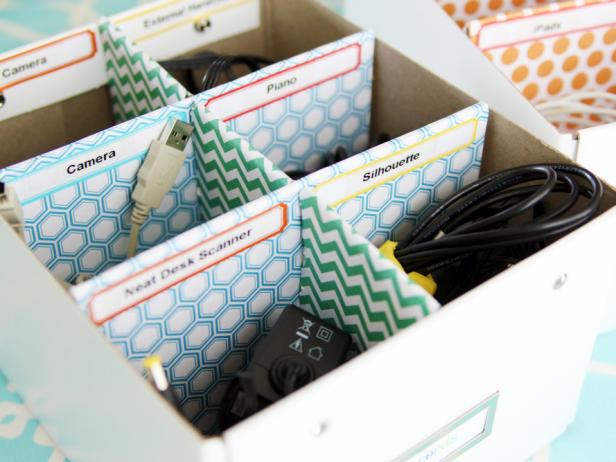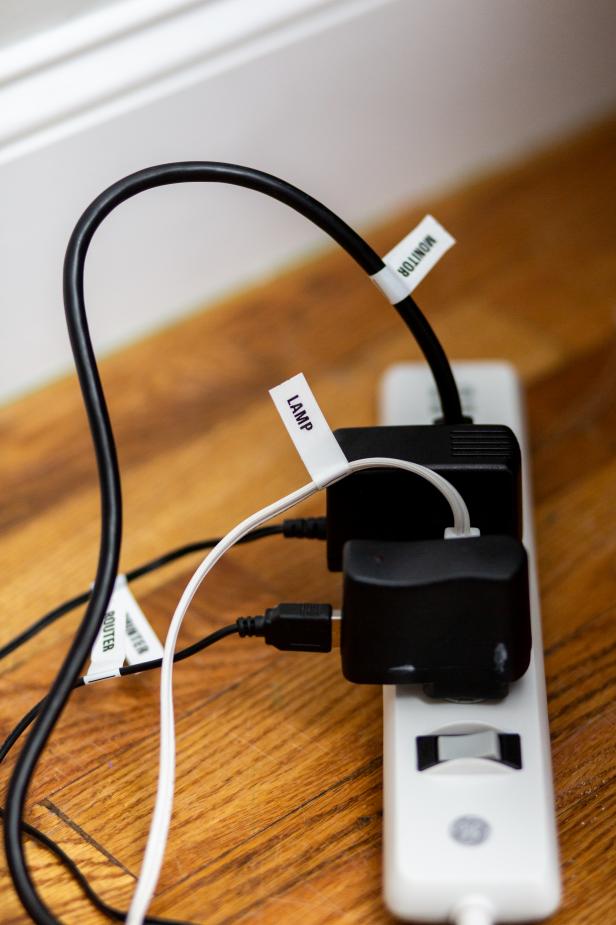"When I go into homes, I see two issues," says professional organizer Lori Gersh, owner of Leave It 2 Lori of Calabasas, California. "There are the active cords you use around your desk, and then there's the issue of managing all the cords people seem to have collected over their life. Most people have a home full of cords and they have no idea what they are used for, but feel this need to keep them."
Photo courtesy of Jennifer Jones
"Instead," says Gersh, "sort your cords and keep out the ones you use daily; store the rest. Avoid leaving them loose in a drawer. A better option: use a clear shoebox to hold bundled and labeled cords." You can also use cardboard scraps to create separate “cubbies” for each cord, like Jennifer Jones of IHeart Organizing did here.
"It's like any other organizing project," says Gersh. "You want to purge, sort, contain and label. When you're talking about your desk and cords, it really doesn't take that long to take control and label them — maybe 15 minutes or so — and the benefits are long-lasting." Here are Gersh's best tips for taking control of the cord clutter.
Safety First
Because you're dealing with cords and electrical devices, consider safety before anything else. Never use staples or nails to secure or store cords on a wall. Also, follow the instructions that come with your surge protector, so you know how many cords can be safely plugged into a single outlet. "When you're using a surge protector, make sure there is no paper around and no cords are frayed," adds Gersh. "You also need to keep that area clean, since dust can build up. It's not just a safety issue, it's a health issue too. You want to be able to vacuum to remove the dust, and you can't do that if the area is cluttered with a bunch of loose cords."
Label the Cords
To avoid confusion when setting up or dismantling equipment in your home office, identify cords by using a label at the base of each one. This helps you match up the cord with the appropriate appliance or media component. "I like to use a label maker, or you can use masking tape with a metallic Sharpie to identify it at the base of the cord," says Gersh. "If you have other people in your home who use the office, it allows everyone to know what goes with what." Many people find that color-coding cords is the way to go. There are products available to help, or you can use bread tags as an easy way to identify specific cords for quick reference.
Eye hooks and zip ties that keep cords mounted to the underside of a desk, or a cord management strap that adheres to the back of your desk, are two options. There are also cable zip devices that keep all the cords together in a protected way. "It makes your room aesthetically look better when you bind the cords together," says Gersh.
And don't forget to toss cords when you get rid of old office equipment and accessories. Instead of dumping them into your household garbage, check for a local recycling center that takes electronic devices.



